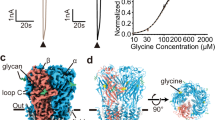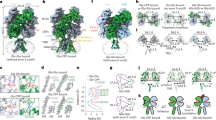Abstract
5-Hydroxytryptamine type 3 (5-HT3) receptors are members of the Cys-loop receptor superfamily1. Neurotransmitter binding in these proteins triggers the opening (gating) of an ion channel by means of an as-yet-uncharacterized conformational change. Here we show that a specific proline (Pro 8*), located at the apex of the loop between the second and third transmembrane helices (M2–M3)2,3, can link binding to gating through a cis–trans isomerization of the protein backbone. Using unnatural amino acid mutagenesis, a series of proline analogues with varying preference for the cis conformer was incorporated at the 8* position. Proline analogues that strongly favour the trans conformer produced non-functional channels. Among the functional mutants there was a strong correlation between the intrinsic cis–trans energy gap of the proline analogue and the activation of the channel, suggesting that cis–trans isomerization of this single proline provides the switch that interconverts the open and closed states of the channel. Consistent with this proposal, nuclear magnetic resonance studies on an M2–M3 loop peptide reveal two distinct, structured forms. Our results thus confirm the structure of the M2–M3 loop and the critical role of Pro 8* in the 5-HT3 receptor. In addition, they suggest that a molecular rearrangement at Pro 8* is the structural mechanism that opens the receptor pore.
This is a preview of subscription content, access via your institution
Access options
Subscribe to this journal
Receive 51 print issues and online access
$199.00 per year
only $3.90 per issue
Buy this article
- Purchase on Springer Link
- Instant access to full article PDF
Prices may be subject to local taxes which are calculated during checkout





Similar content being viewed by others
References
Lester, H. A., Dibas, M. I., Dahan, D. S., Leite, J. F. & Dougherty, D. A. Cys-loop receptors: new twists and turns. Trends Neurosci. 27, 329–336 (2004)
Meeus, N. & Lummis, S. C. R. Proline 307 in the mouse 5–HT3a receptor links binding and function. pa2online 1, 015P (2003)
Lummis, S. C. R. The transmembrane domain of the 5-HT3 receptor: its role in selectivity and gating. Biochem. Soc. Trans. 32, 535–539 (2004)
Bera, A. K., Chatav, M. & Akabas, M. H. GABAA receptor M2–M3 loop secondary structure and changes in accessibility during channel gating. J. Biol. Chem. 277, 43002–43010 (2002)
Grosman, C., Salamone, F. N., Sine, S. M. & Auerbach, A. The extracellular linker of muscle acetylcholine receptor channels is a gating control element. J. Gen. Phys. 116, 327–339 (2000)
Lynch, J. W., Han, N. L. R., Haddrill, J., Pierce, K. D. & Schofield, P. R. The surface accessibility of the glycine receptor M2–M3 loop is increased in the channel open state. J. Neurosci. 21, 2589–2599 (2001)
Kash, T. L., Jenkins, A., Kelley, J. C., Trudell, J. R. & Harrison, N. L. Coupling of agonist binding to channel gating in the GABAA receptor. Nature 421, 272–275 (2003)
Unwin, N. Refined structure of the nicotinic acetylcholine receptor at 4 Å resolution. J. Mol. Biol. 346, 967–989 (2005)
Nowak, M. W. et al. In vivo incorporation of unnatural amino acids into ion channels in Xenopus oocyte expression system. Methods Enzymol. 293, 504–529 (1998)
Macarthur, M. W. & Thornton, J. M. Influence of proline residues on protein conformation. J. Mol. Biol. 218, 397–412 (1991)
Dang, H., England, P. M., Farivar, S. S., Dougherty, D. A. & Lester, H. A. Probing the role of a conserved M1 proline residue in 5-hydroxytryptamine(3) receptor gating. Mol. Pharm. 57, 1114–1122 (2000)
Jabs, A., Weiss, M. S. & Hilgenfeld, R. Non-proline cis peptide bonds in proteins. J. Mol. Biol. 286, 291–304 (1999)
Dugave, C. & Demange, L. Cis-trans isomerization of organic molecules and biomolecules: Implications and applications. Chem. Rev. 103, 2475–2532 (2003)
Colquhoun, D. Binding, gating, affinity and efficacy: the interpretation of structure-activity relationships for agonists and of the effects of mutating receptors. Br. J. Pharmacol. 125, 924–947 (1998)
Miyazawa, A., Fujiyoshi, Y. & Unwin, N. Structure and gating mechanism of the acetylcholine receptor pore. Nature 423, 949–955 (2003)
Taly, A. et al. Normal mode analysis suggests a quaternary twist model for the nicotinic receptor gating mechanism. Biophys. J. 88, 3954–3965 (2005)
Zhong, W. et al. From ab initio quantum mechanics to molecular neurobiology: A cation-π binding site in the nicotinic receptor. Proc. Natl Acad. Sci. USA 95, 12088–12093 (1998)
Beene, D. L. et al. Cation-π interactions in ligand recognition by serotonergic (5–HT3A) and nicotinic acetylcholine receptors: The anomalous binding properties of nicotine. Biochemistry 41, 10262–10269 (2002)
Brejc, K. et al. Crystal structure of an ACh-binding protein reveals the ligand-binding domain of nicotinic receptors. Nature 411, 269–276 (2001)
Gao, F. et al. Agonist-mediated conformational changes in acetylcholine-binding protein revealed by simulation and intrinsic tryptophan fluorescence. J. Biol. Chem. 280, 8443–8451 (2005)
An, S. S. A. et al. Retention of the cis proline conformation in tripeptide fragments of bovine pancreatic ribonuclease A containing a non-natural proline analogue, 5,5-dimethylproline. J. Am. Chem. Soc. 121, 11558–11566 (1999)
Kern, D., Schutkowski, M. & Drakenberg, T. Rotational barriers of cis/trans isomerization of proline analogues and their catalysis by cyclophilin. J. Am. Chem. Soc. 119, 8403–8408 (1997)
Halab, L. & Lubell, W. D. Use of steric interactions to control peptide turn geometry. Synthesis of type VI β-turn mimics with 5-tert-Butylproline. J. Org. Chem. 64, 3312–3321 (1999)
Breitinger, H. G., Geetha, N. & Hess, G. P. Inhibition of the serotonin 5-HT3 receptor by nicotine, cocaine, and fluoxetine investigated by rapid chemical kinetic techniques. Biochemistry 40, 8419–8429 (2001)
Kelley, S. P., Dunlop, J. I., Kirkness, E. F., Lambert, J. J. & Peters, J. A. A cytoplasmic region determines single-channel conductance in 5-HT3 receptors. Nature 424, 321–324 (2003)
Cox, C. & Lectka, T. Intramolecular catalysis of amide isomerization: Kinetic consequences of the 5-NH- -Na hydrogen bond in prolyl peptides. J. Am. Chem. Soc. 120, 10660–10668 (1998)
Brandl, C. J. & Deber, C. M. Hypothesis about the function of membrane-buried proline residues in transport proteins. Proc. Natl Acad. Sci. USA 83, 917–921 (1986)
Sansom, M. S. P. & Weinstein, H. Hinges, swivels and switches: the role of prolines in signalling via transmembrane α-helices. Trends Pharm. Sci. 21, 445–451 (2000)
Beene, D. L., Price, K. L., Lester, H. A., Dougherty, D. A. & Lummis, S. C. R. L. Tyrosine residues that control binding and gating in the 5-hydroxytryptamine3 receptor revealed by unnatural amino acid mutagenesis. J. Neurosci. 24, 9097–9104 (2004)
Reeves, D. C., Sayed, M. R. F., Chau, P. L., Price, K. L. & Lummis, S. C. R. Prediction of 5-HT3 receptor agonist-binding residues using homology modeling. Biophys. J. 84, 2338–2344 (2003)
Acknowledgements
S.C.R.L. is a Wellcome Trust Senior Research Fellow in Basic Biomedical Science. The work at Caltech was supported by the National Institutes of Health. We thank K. L. Price and A. J. Thompson for assistance with modelling.
Author information
Authors and Affiliations
Corresponding author
Ethics declarations
Competing interests
Reprints and permissions information is available at npg.nature.com/reprintsandpermissions. The authors declare no competing financial interests.
Supplementary information
Supplementary Notes
This file contains Supplementary Methods, Supplementary Figures 1–3 and Supplementary Table 1. (PDF 260 kb)
Rights and permissions
About this article
Cite this article
Lummis, S., Beene, D., Lee, L. et al. Cis–trans isomerization at a proline opens the pore of a neurotransmitter-gated ion channel. Nature 438, 248–252 (2005). https://doi.org/10.1038/nature04130
Received:
Accepted:
Issue Date:
DOI: https://doi.org/10.1038/nature04130
This article is cited by
-
Cis-trans isomerization of peptoid residues in the collagen triple-helix
Nature Communications (2023)
-
Proline metabolism and redox; maintaining a balance in health and disease
Amino Acids (2021)
-
Prolyl isomerization controls activation kinetics of a cyclic nucleotide-gated ion channel
Nature Communications (2020)
-
Amide nitrogen pyramidalization changes lactam amide spinning
Nature Communications (2019)
-
Orthogonality of Pyrrolysine tRNA in the Xenopus oocyte
Scientific Reports (2018)
Comments
By submitting a comment you agree to abide by our Terms and Community Guidelines. If you find something abusive or that does not comply with our terms or guidelines please flag it as inappropriate.



